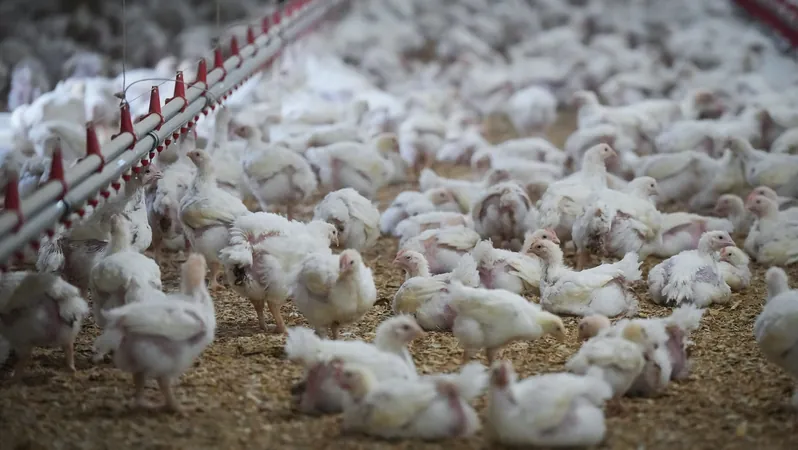
Are Bird Flu, Lyme Disease, and Rabies New Threats? What You Need to Know!
2024-12-29
Author: Jacob
California's recent declaration of a public health emergency due to bird flu has put zoonotic diseases—those that can spread between animals and humans—back in the spotlight. Following the case of a British Columbia teenager who spent weeks hospitalized after contracting avian influenza, the urgency to understand these diseases has never been more critical. Just last year, a shocking 24,000 sea lions along the Chilean coast were lost to H5N1, raising alarms about the virus’s potential to leap between species.
Facing the Threat of H5N1
Bird flu, officially known as the H5N1 strain, predominantly affects wild birds such as ducks and geese. The Lower Mainland of British Columbia lies along the Pacific Flyway, making it a prime location for migratory birds that can carry this virus. The Canadian Food Inspection Agency has reported an alarming culling of over 8.3 million birds in B.C. to curb this outbreak, with Alberta following behind at two million.
The H5N1 strain is particularly concerning as it has a staggering mortality rate of about 50% in children, compared to milder symptoms typically seen in adults. Although there have only been around 900 confirmed human cases since its identification in 1997, the World Health Organization has warned that the virus could mutate, increasing the likelihood of sustained human-to-human transmission—a scenario experts fear most.
Dr. Mayank Singal from the BC Centre for Disease Control emphasizes the importance of avoiding contact with sick or dead birds and educating the public on the proper handling of potential cases.
Chronic Wasting Disease: A Hidden Danger
Chronic wasting disease (CWD) poses its own risks, affecting cervids such as deer and elk. Unlike typical viral infections, CWD is caused by prions—misfolded proteins that leave holes in the brain. Notably, four confirmed cases of CWD have been reported in B.C., and public health officials are vigilant, monitoring deer populations closely.
Although cross-species transmission to humans is rare, it is theoretically possible. Thus, the public is advised to steer clear of sick or deceased cervids, and mandatory testing of harvested deer in specific areas is in place to safeguard against potential health risks.
Lyme Disease: Ticking Upward
As climate change prolongs warm seasons, tick-borne diseases, including Lyme disease, are on the rise throughout Canada. Fortunately, B.C. has reported stable, albeit low, cases of Lyme disease over the past nine years, with only a fraction arising locally. However, the situation in Central and Eastern Canada paints a different picture, with reported cases skyrocketing from 144 in 2009 to over 2,500 in 2023.
Preventive measures are simple yet effective: dress appropriately when venturing into wooded areas, use insect repellent, and conduct thorough body checks after outdoor activities. The sooner a tick is removed, the lesser the risk of pathogens being transmitted.
The Rabies Reality: Rare But Serious
Rabies presents a contrasting scenario in B.C. While the disease remains a fearsome threat worldwide—resulting in approximately 55,000 fatalities annually—B.C. experiences it primarily within bat populations. With rabies practically absent among terrestrial wildlife, your risk of encountering a rabid animal is quite low, especially with domestic pets.
Yet, when interactions occur, it’s vital to act swiftly. Should someone be bitten or scratched by a potentially infected animal, immediate medical intervention is critical, as rabies is nearly always fatal once symptoms manifest. Rabies vaccinations are suggested for pets, but they are not mandatory in B.C.
In conclusion, while bird flu, chronic wasting disease, Lyme disease, and rabies pose different levels of risk, a proactive approach to personal safety—staying informed, prepared, and cautious—can mitigate these threats. Stay tuned, stay safe, and keep those outdoor plans in check!



 Brasil (PT)
Brasil (PT)
 Canada (EN)
Canada (EN)
 Chile (ES)
Chile (ES)
 Česko (CS)
Česko (CS)
 대한민국 (KO)
대한민국 (KO)
 España (ES)
España (ES)
 France (FR)
France (FR)
 Hong Kong (EN)
Hong Kong (EN)
 Italia (IT)
Italia (IT)
 日本 (JA)
日本 (JA)
 Magyarország (HU)
Magyarország (HU)
 Norge (NO)
Norge (NO)
 Polska (PL)
Polska (PL)
 Schweiz (DE)
Schweiz (DE)
 Singapore (EN)
Singapore (EN)
 Sverige (SV)
Sverige (SV)
 Suomi (FI)
Suomi (FI)
 Türkiye (TR)
Türkiye (TR)
 الإمارات العربية المتحدة (AR)
الإمارات العربية المتحدة (AR)